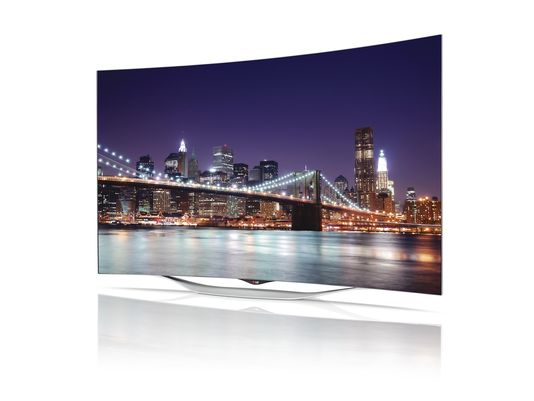LG's OLED HDTV: New features, lower price
HTTP/1.1 200 OK Server: nginx/1.2.7 Content-Type: text/html; charset=utf-8 Content-Language: en Last-Modified: Mon, 11 Aug 2014 05:06:28 GMT X-UA-Compatible: IE=Edge,chrome=1 X-Secret: cnpudnkgcnpiZXZnbUBoZm5nYnFubC5wYnogbmFxIFYganZ5eSBnZWwgZ2IgdHJnIGxiaCBuIHdiby4= Cache-Control: max-age=20 Expires: Mon, 11 Aug 2014 05:07:42 GMT Date: Mon, 11 Aug 2014 05:07:22 GMT Transfer-Encoding: chunked Connection: keep-alive Connection: Transfer-Encoding
Corrections & Clarifications: An earlier version of this story misstated what the acronym OLED stands for. It is organic light-emitting diode technology.
The holy grail of TVs is becoming more attainable.
LG Electronics is bringing to market the first full-sized OLED (organic-light-emitting diode) HDTV aimed at mainstream consumers.
OK, the new super-thin and curved 55-inch display still costs $3,499.99. But that's quite a reduction in the introductory price of a new OLED, compared to the $15,000 and $16,000 price tags on LG's first two models.
This new display, available for pre-order now on BestBuy.com [1]and in Best Buy stores Aug. 24 is less than one-sixth of an inch thick — the thickness of a few credit cards.
The price is "still at the high end of a 55-inch (high-definition TV), but not as lofty as the first-generation models were," says Tim Alessi, LG Electronic's director of new product development. "We think the demand is going to be considerable for this model."
About a decade ago, OLED began being held up as the eventual holy grail of TVs because the technology produced the most realistic images, with rich blacks and colors that pop.
"OLEDs still make for astonishing TVs, with great picture quality, (and are) more energy efficient and extremely thin," says Veronica Gonzalez-Thayer, an analyst with IHS Technology.
But LED-backlight LCD TVs also have improved, she says, making it difficult for OLEDs to differentiate themselves in the TV market and "justify their premium price."
Many competitors including Samsung, Sony and Panasonic have dropped out of OLED TV production, although Sony recently announced a new venture with Panasonic and the Japan Display and Innovation Network Corp, a government-backed firm that would have a majority stake.
With its head start, LG hopes that its ability to produce enough displays and keep prices low will help it stand out in the marketplace. "A lot of others have tried to come out with it. We have been able to stick with it," Alessi says.
Best Buy gets first crack at the new OLEDs and the electronics chain thinks consumers will see the benefits. "You get that full gamut of colors without any type of color distortion," says Luke Mothschenbacher, merchant director of televisions at Best Buy. "OLED takes plasma color saturation to a different level."
The displays have a new Smart TV operating system based on WebOS, which LG acquired last year from Hewlett-Packard, as well as a wireless gesture-controlled LG Magic remote. There is also a pedestal stand that can be used to rest the TV on a tabletop or be removed for on-the-wall mounting.
LG's first curved U.S. OLED model[2], originally brought to market last year for $14,999, has been reduced to make way for the new curved display and is being advertised for as low as $3,300. Its flat-panel OLED, with hidden speakers within its picture-frame housing, introduced last year for $15,999, can be found for $5,000.
LG has other OLED TV models in the works including larger displays that boast Ultra HD resolution, four times that of HDTV. The Korean-headquartered electronics maker showed off 65-inch and 77-inch OLED Ultra HD displays at the Consumer Electronics Show in January.
"Our nickname for (OLED) is 'the ultimate display' because that is really what it is," Alessi says. "There is nothing that can touch it in the overall balance of picture quality and design."
Follow Mike Snider on Twitter: @MikeSnider[3]
Read or Share this story: http://usat.ly/1okzobe










